太阳系行星英文简介
- 格式:ppt
- 大小:2.51 MB
- 文档页数:16
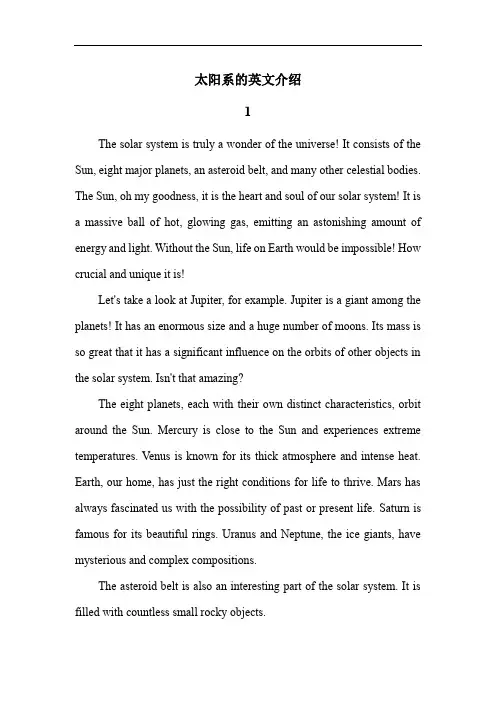
太阳系的英文介绍1The solar system is truly a wonder of the universe! It consists of the Sun, eight major planets, an asteroid belt, and many other celestial bodies. The Sun, oh my goodness, it is the heart and soul of our solar system! It is a massive ball of hot, glowing gas, emitting an astonishing amount of energy and light. Without the Sun, life on Earth would be impossible! How crucial and unique it is!Let's take a look at Jupiter, for example. Jupiter is a giant among the planets! It has an enormous size and a huge number of moons. Its mass is so great that it has a significant influence on the orbits of other objects in the solar system. Isn't that amazing?The eight planets, each with their own distinct characteristics, orbit around the Sun. Mercury is close to the Sun and experiences extreme temperatures. Venus is known for its thick atmosphere and intense heat. Earth, our home, has just the right conditions for life to thrive. Mars has always fascinated us with the possibility of past or present life. Saturn is famous for its beautiful rings. Uranus and Neptune, the ice giants, have mysterious and complex compositions.The asteroid belt is also an interesting part of the solar system. It is filled with countless small rocky objects.The solar system is a complex and fascinating system that continues to inspire our curiosity and exploration. How much more do we have yet to discover?2The solar system is a vast and mysterious realm that has always captivated the human imagination! How did it come into being? It's a story full of unknowns and miracles. It is believed that it originated from a massive cloud of gas and dust that collapsed under its own gravity. This process gave birth to the sun at the center, surrounded by planets, asteroids, and comets.The exploration of the solar system by humans is a remarkable journey. Space probes like V oyager 1 and 2 have ventured far beyond our home planet, sending back precious data and images. We have discovered the rings of Saturn, the geysers on Enceladus, and the possibility of liquid water on Mars. How astonishing is that?Yet, there is still so much more to uncover. What lies beneath the icy crust of Europa? Could there be life on other planets or moons? The questions keep coming, and the quest for answers continues. The solar system is a never-ending source of wonder and excitement. It reminds us of how small we are in this vast universe, but also of the power of human curiosity and determination to seek knowledge. Isn't it fascinating?3The solar system is a fascinating and complex entity! It consists of the sun, planets, moons, asteroids, comets, and other celestial bodies. The planets orbit around the sun in elliptical paths, and their orbital periods vary greatly. For example, Mercury takes only about 88 Earth days to complete one orbit, while Neptune needs a whopping 165 years! The rotation periods of the planets also differ significantly. The distance between a planet and the sun plays a crucial role in determining its climate and environment. Planets closer to the sun, like Mercury and Venus, experience extreme temperatures, while those farther away, such as Neptune and Uranus, have much colder conditions. What's more, asteroids and comets pose potential threats to the stability of the solar system. They could collide with planets or disrupt the orbits of other celestial bodies. Isn't it astonishing to think about the delicate balance and the countless possibilities of interactions within our solar system? We are constantly learning and exploring, seeking to understand the mysteries and wonders of this cosmic neighborhood. How much more do we have yet to discover? The solar system is truly a source of endless curiosity and exploration!4The solar system is an amazing and vast cosmic wonder! It is a collection of celestial bodies that hold countless mysteries and wonders. Atthe center lies the Sun, a huge and powerful star that provides light and heat to all the planets. The planets orbit around the Sun in a specific order. There are eight planets in total - Mercury, the closest to the Sun, is a small and rocky world. Venus, often called Earth's sister planet, has a thick atmosphere. Earth, our home, is a unique planet with life and a suitable environment. Mars, known for its reddish appearance, has been the subject of much exploration. Beyond these inner planets, there are the gas giants - Jupiter, the largest planet, with its massive size and beautiful bands. Saturn, famous for its rings, is truly a sight to behold. Uranus and Neptune, the ice giants, are far away and have their own special characteristics.The solar system is not like other galaxies. How different is it? It has a relatively stable structure and a specific arrangement of planets. But compared to other galaxies, it might seem small and simple. However, for us, it is a source of endless exploration and discovery. Isn't it fascinating? We are still learning and uncovering more about this wonderful solar system!5The solar system is a vast and magnificent cosmic wonder! How astonishing it is to think about the various celestial bodies that orbit our sun. When we consider the possibility of life, Earth stands out as a unique gem. With its moderate temperatures, abundant water, and a suitable atmosphere, it provides the ideal conditions for life to thrive. But whatabout the other planets? Mars, for instance, has long intrigued scientists. Could it have once supported microbial life? Or might it do so in the future? Jupiter, with its massive size and powerful gravitational pull, plays a crucial role in safeguarding the inner planets from potential asteroids. And Saturn, oh, Saturn! Its glorious rings are a sight to behold. They add an aesthetic charm that makes us wonder about the beauty and mystery of the universe. The colors and shapes of these planets and their moons are a source of endless fascination. Isn't it mind-boggling to think about the vastness and complexity of our solar system? It's a universe of possibilities and questions that keep us looking up and seeking answers.。
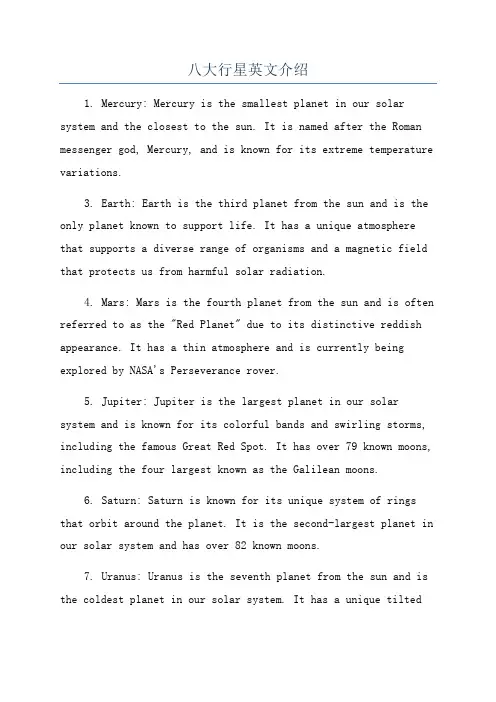
八大行星英文介绍1. Mercury: Mercury is the smallest planet in our solar system and the closest to the sun. It is named after the Roman messenger god, Mercury, and is known for its extreme temperature variations.3. Earth: Earth is the third planet from the sun and is the only planet known to support life. It has a unique atmosphere that supports a diverse range of organisms and a magnetic field that protects us from harmful solar radiation.4. Mars: Mars is the fourth planet from the sun and is often referred to as the "Red Planet" due to its distinctive reddish appearance. It has a thin atmosphere and is currently being explored by NASA's Perseverance rover.5. Jupiter: Jupiter is the largest planet in our solar system and is known for its colorful bands and swirling storms, including the famous Great Red Spot. It has over 79 known moons, including the four largest known as the Galilean moons.6. Saturn: Saturn is known for its unique system of rings that orbit around the planet. It is the second-largest planet in our solar system and has over 82 known moons.7. Uranus: Uranus is the seventh planet from the sun and is the coldest planet in our solar system. It has a unique tiltedrotational axis, causing it to have extreme seasons that lastfor over 20 Earth years.8. Neptune: Neptune is the eighth and farthest planet from the sun and is known for its vibrant blue color. It has a strong magnetic field and is the only planet discovered through mathematical predictions rather than direct observation.。
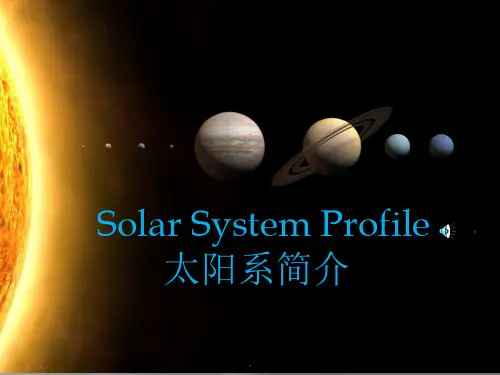

介绍太阳系的星球英语作文Mercury is the closest planet to the sun and it is also the smallest planet in the solar system. It is a rocky planet with a surface that is covered in craters.Venus is often called Earth's "sister planet" because they are similar in size and composition. It is the hottest planet in the solar system due to its thick atmosphere that traps heat.Earth is the only planet in the solar system known to support life. It has a diverse range of environments, from oceans to mountains, and is the only planet with liquid water on its surface.Mars is often called the "Red Planet" because of its reddish appearance. It has the largest volcano and the longest canyon in the solar system.Jupiter is the largest planet in the solar system andit is known for its giant storm called the Great Red Spot. It has a strong magnetic field and more than 70 moons.Saturn is famous for its beautiful ring system, which is made up of ice particles and dust. It has the second-largest moon in the solar system, Titan.Uranus is unique because it is tilted on its side, causing it to rotate on its side as well. It is often referred to as an "ice giant" because it is made up mostly of water, ammonia, and methane.Neptune is the farthest planet from the sun and it is known for its deep blue color. It has the strongest winds in the solar system, with speeds of up to 1,500 miles per hour.。

太阳系八大行星的英语The Eight Planets of the Solar SystemIntroduction:The solar system consists of the sun and a group of celestial bodies that orbit around it. There are eight major planets in our solar system, each with its own unique characteristics and properties. In this document, we will provide an overview of the eight planets, their composition, physical features, and interesting facts.1. Mercury:Mercury is the smallest planet in the solar system and closest to the sun. It has a rocky surface with numerous craters caused by meteorite impacts. Due to its proximity to the sun, temperatures on Mercury can reach extreme highs during the day and drop significantly at night. It does not have an atmosphere and has a very thin layer of gases surrounding it.2. Venus:Venus is often referred to as Earth's sister planet due to its similar size and composition. It is the hottest planet in our solar system, with a thick atmosphere that traps the sun's heat, leading to a runaway greenhouse effect. Venus is covered in thick clouds composed mainly of sulfuric acid, making its surface hidden from view.3. Earth:Our home planet, Earth, is the third planet from the sun and the only known planet to support life. It has a diverserange of ecosystems, including oceans, mountains, forests, and deserts. Earth has an atmosphere consisting of mainly nitrogen and oxygen, which helps to regulate temperatures and preserve life. It is also the only planet to have liquid water on its surface.4. Mars:Mars, often referred to as the "Red Planet," is known for its reddish appearance due to iron oxide, also known as rust, covering its surface. Mars has polar ice caps, similar to Earth's, and evidence of ancient rivers and lakes. It has a thin atmosphere consisting mainly of carbon dioxide. Scientists continue to study Mars for signs of past or present life.5. Jupiter:Jupiter is the largest planet in our solar system and is primarily composed of hydrogen and helium. It is known for its distinctive bands of clouds and the Great Red Spot, a massive storm that has been raging for hundreds of years. Jupiter has numerous moons, with the four largest ones known as the Galilean moons: Io, Europa, Ganymede, and Callisto.6. Saturn:Saturn is recognized for its beautiful ring system, composed of ice and rock particles. It is the second-largest planet and mainly consists of hydrogen and helium. Saturn's rings are made up of thousands of individual ringlets that vary in size and thickness. Like Jupiter, Saturn has numerous moons, with Titan being the largest and most interesting due to its thick atmosphere and potential for supporting life.7. Uranus:Uranus is a unique planet in our solar system, known for its sideways orientation. It is composed mainly ofhydrogen and helium, along with small amounts of water, methane, and ammonia. Uranus has a bluish-green appearance due to the presence of methane in its atmosphere. It has a system of rings, but they are much fainter and narrower compared to Saturn's.8. Neptune:Neptune is the farthest planet from the sun and one of the windiest places in the solar system. It is composed mainly of hydrogen and helium, with traces of methane giving it a blue color. Neptune has a distinct feature called the Great Dark Spot, similar to Jupiter's Great Red Spot. It has a system of rings, but they are very faint and difficult to observe.Conclusion:The eight planets of our solar system offer a diverse range of compositions, physical features, and interesting facts. From the scorching hot Venus to the windy and distant Neptune, each planet provides us with valuable information about the formation and evolution of our solar system. Although we have yet to fully explore and understand these fascinating celestial bodies, ongoing research and exploration continue to unveil new discoveries and broaden our knowledge of the solar system.。
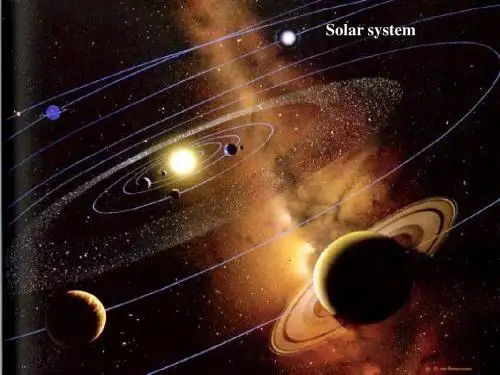
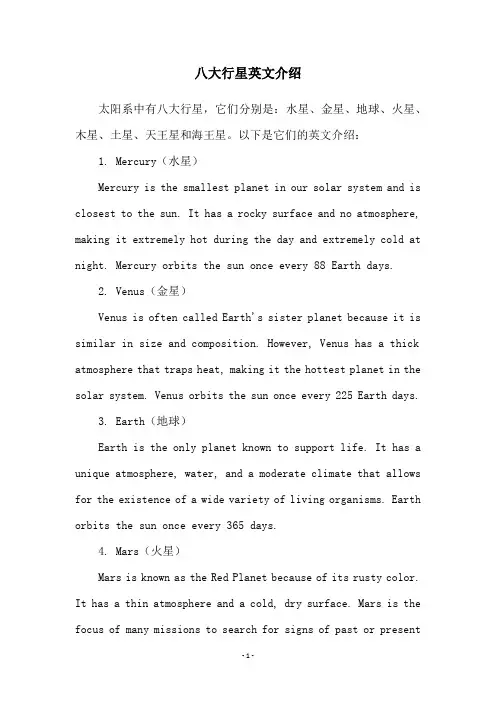
八大行星英文介绍太阳系中有八大行星,它们分别是:水星、金星、地球、火星、木星、土星、天王星和海王星。
以下是它们的英文介绍:1. Mercury(水星)Mercury is the smallest planet in our solar system and is closest to the sun. It has a rocky surface and no atmosphere, making it extremely hot during the day and extremely cold at night. Mercury orbits the sun once every 88 Earth days.2. Venus(金星)Venus is often called Earth's sister planet because it is similar in size and composition. However, Venus has a thick atmosphere that traps heat, making it the hottest planet in the solar system. Venus orbits the sun once every 225 Earth days.3. Earth(地球)Earth is the only planet known to support life. It has a unique atmosphere, water, and a moderate climate that allows for the existence of a wide variety of living organisms. Earth orbits the sun once every 365 days.4. Mars(火星)Mars is known as the Red Planet because of its rusty color. It has a thin atmosphere and a cold, dry surface. Mars is the focus of many missions to search for signs of past or presentlife. Mars orbits the sun once every 687 Earth days.5. Jupiter(木星)Jupiter is the largest planet in our solar system and has over 80 moons. It is a gas giant with no solid surface. Jupiter has a strong magnetic field and is known for its colorful bands of clouds. Jupiter orbits the sun once every 12 Earth years.6. Saturn(土星)Saturn is also a gas giant and is known for its spectacular rings, made up of countless individual particles of ice and rock. Saturn has over 60 moons and is the least dense planet in the solar system. Saturn orbits the sun once every 29 Earth years.7. Uranus(天王星)Uranus is an ice giant, meaning it is mostly made up of water, methane, and ammonia ices. It has a tilted axis, causing its seasons to be extreme and its magnetic field to be off-center. Uranus has 27 known moons and orbits the sun once every 84 Earth years.8. Neptune(海王星)Neptune is the farthest planet from the sun and is also an ice giant. It has a deep blue color due to the methane in its atmosphere. Neptune has 14 known moons and orbits the sun once every 165 Earth years.以上是关于八大行星的英文介绍。
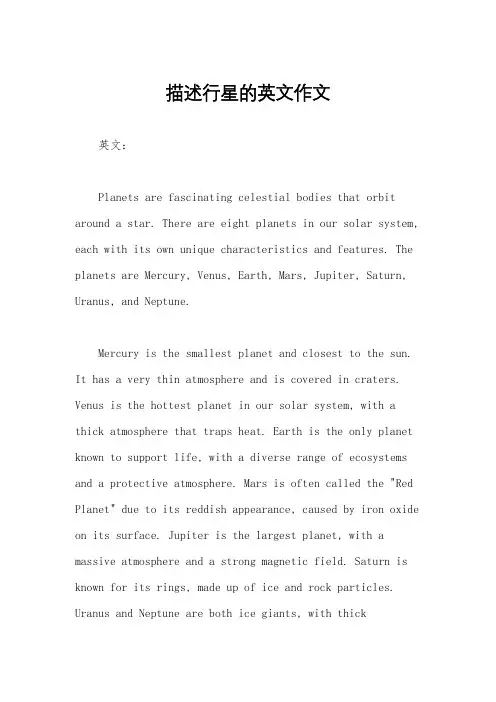
描述行星的英文作文英文:Planets are fascinating celestial bodies that orbit around a star. There are eight planets in our solar system, each with its own unique characteristics and features. The planets are Mercury, Venus, Earth, Mars, Jupiter, Saturn, Uranus, and Neptune.Mercury is the smallest planet and closest to the sun. It has a very thin atmosphere and is covered in craters. Venus is the hottest planet in our solar system, with a thick atmosphere that traps heat. Earth is the only planet known to support life, with a diverse range of ecosystems and a protective atmosphere. Mars is often called the "Red Planet" due to its reddish appearance, caused by iron oxide on its surface. Jupiter is the largest planet, with a massive atmosphere and a strong magnetic field. Saturn is known for its rings, made up of ice and rock particles. Uranus and Neptune are both ice giants, with thickatmospheres and icy surfaces.Each planet has its own unique characteristics that make it interesting to study. For example, Mars has ahistory of water on its surface, which makes it a prime target for studying the possibility of past or present life. Jupiter's moons are also fascinating, with some potentially harboring life under their icy surfaces.Overall, planets are important to study as they provide insight into the formation and evolution of our solar system, as well as the possibility of life beyond Earth.中文:行星是围绕恒星运行的神秘天体。
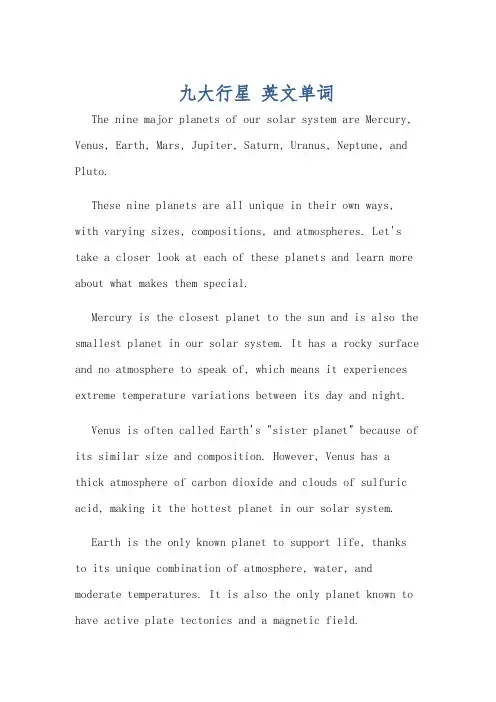
九大行星英文单词The nine major planets of our solar system are Mercury, Venus, Earth, Mars, Jupiter, Saturn, Uranus, Neptune, and Pluto.These nine planets are all unique in their own ways, with varying sizes, compositions, and atmospheres. Let's take a closer look at each of these planets and learn more about what makes them special.Mercury is the closest planet to the sun and is also the smallest planet in our solar system. It has a rocky surface and no atmosphere to speak of, which means it experiences extreme temperature variations between its day and night.Venus is often called Earth's "sister planet" because of its similar size and composition. However, Venus has athick atmosphere of carbon dioxide and clouds of sulfuric acid, making it the hottest planet in our solar system.Earth is the only known planet to support life, thanksto its unique combination of atmosphere, water, and moderate temperatures. It is also the only planet known to have active plate tectonics and a magnetic field.Mars is often called the "Red Planet" because of its reddish appearance, caused by iron oxide on its surface. It has the largest volcano and the deepest canyon in our solar system, as well as evidence of ancient rivers and lakes.Jupiter is the largest planet in our solar system and is known for its massive size and powerful storms, including the famous Great Red Spot. It is composed mostly of hydrogen and helium and has a strong magnetic field.Saturn is known for its beautiful rings, which are made up of ice, rock, and dust particles. It is the second-largest planet in our solar system and has the most extensive ring system.Uranus is unique among the planets because it rotates on its side, likely due to a collision with another object early in its history. It is composed mostly of ices and rock and has a bluish-green color due to the presence of methane in its atmosphere.Neptune is the farthest planet from the sun and is known for its deep blue color, caused by the presence of methane in its atmosphere. It has the strongest winds in our solarsystem and is the only planet discovered through mathematical prediction rather than direct observation.Pluto was reclassified as a "dwarf planet" in 2006, but it still holds a special place in our solar system. It has a highly elliptical orbit and is the largest known member of the Kuiper Belt, a region of icy bodies beyond Neptune.These nine planets, along with their moons, asteroids, and other celestial bodies, make up our solar system and continue to fascinate scientists and astronomers with their unique features and mysteries.这九大行星是水星,金星,地球,火星,木星,土星,天王星,海王星和冥王星。
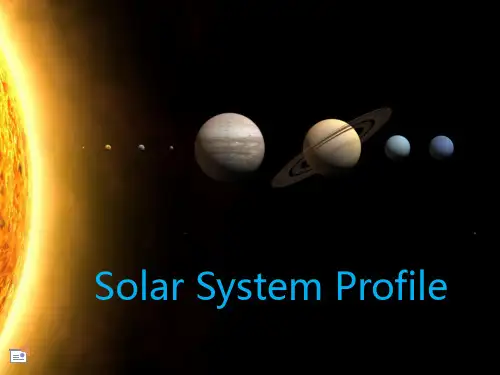
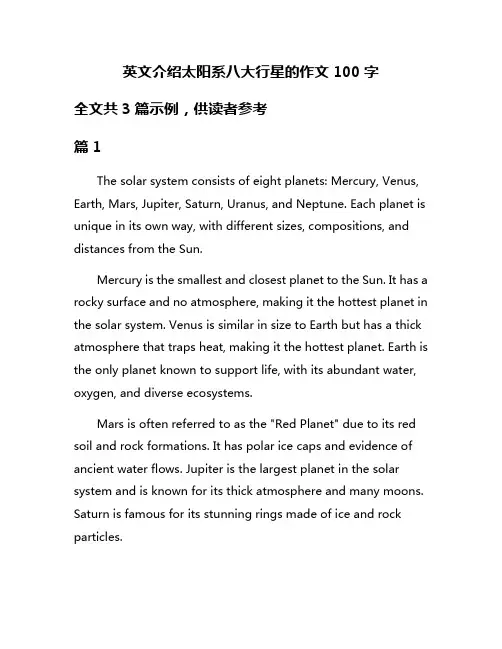
英文介绍太阳系八大行星的作文100字全文共3篇示例,供读者参考篇1The solar system consists of eight planets: Mercury, Venus, Earth, Mars, Jupiter, Saturn, Uranus, and Neptune. Each planet is unique in its own way, with different sizes, compositions, and distances from the Sun.Mercury is the smallest and closest planet to the Sun. It has a rocky surface and no atmosphere, making it the hottest planet in the solar system. Venus is similar in size to Earth but has a thick atmosphere that traps heat, making it the hottest planet. Earth is the only planet known to support life, with its abundant water, oxygen, and diverse ecosystems.Mars is often referred to as the "Red Planet" due to its red soil and rock formations. It has polar ice caps and evidence of ancient water flows. Jupiter is the largest planet in the solar system and is known for its thick atmosphere and many moons. Saturn is famous for its stunning rings made of ice and rock particles.Uranus and Neptune are ice giants with thick atmospheres and unique features. Uranus is tilted on its side, giving it extreme seasons, while Neptune has the fastest winds in the solar system.Overall, the eight planets of the solar system display the diversity and wonder of our cosmic neighborhood. Each planet offers a glimpse into the vastness and complexity of the universe, showcasing the beauty and mysteries of our solar system.篇2The solar system consists of eight major planets, namely Mercury, Venus, Earth, Mars, Jupiter, Saturn, Uranus, and Neptune. Each of these planets has its own unique characteristics and features.Mercury is the closest planet to the sun and is named after the Roman messenger god. It is a small, rocky planet with extreme temperature variations. Venus, sometimes called Earth's sister planet, is known for its thick atmosphere and scorching surface temperatures.Earth is the only planet known to support life, with a diverse range of ecosystems and habitats. Mars, often called the Red Planet due to its reddish appearance, is home to the largest volcano in the solar system, Olympus Mons.Jupiter is the largest planet in the solar system and is known for its massive size and swirling storms, including the Great Red Spot. Saturn, famous for its beautiful rings made of ice and rock particles, is one of the most striking planets to observe.Uranus and Neptune are known as the ice giants of the solar system, with icy atmospheres and unique features such as rings and moons. Neptune, the farthest planet from the sun, is a cold and windy world with a deep blue hue.Overall, the eight planets of the solar system offer a diverse and fascinating array of worlds to explore and study. Each planet has its own distinct characteristics and features that make it a unique and intriguing destination for space exploration.篇3The solar system consists of eight planets, each with its own unique characteristics and features. These planets are Mercury, Venus, Earth, Mars, Jupiter, Saturn, Uranus, and Neptune.Mercury is the smallest and closest planet to the sun. It has a rocky surface and a thin atmosphere. Venus is the hottest planet in the solar system, with temperatures reaching up to 900 degrees Fahrenheit. Earth is the only planet known to support life, with a diverse range of ecosystems and environments.Mars is often referred to as the "Red Planet" due to its reddish appearance. It has a thin atmosphere and evidence of water on its surface. Jupiter is the largest planet in the solar system, with a massive magnetic field and numerous moons. Saturn is known for its beautiful rings made of ice particles and rocks.Uranus and Neptune are the outermost planets in the solar system. Uranus is a gas giant with a unique sideways rotation, while Neptune is a blue planet with strong winds and a dark spot similar to Jupiter's Great Red Spot.Overall, the eight planets in our solar system are diverse and fascinating, each offering a glimpse into the wonders of our universe.。
九大行星的英文名称及来历水星:Mercury水星最接近太阳,是太阳系中第二小行星。
水星的英文名字Mercury来自罗马神墨丘利。
墨丘利也就是希腊神话中的Hermes (赫耳墨斯,为众神传信并掌管商业、道路、科学、发明、口才、幸运等的神) 。
金星:Venus金星是离太阳第二近,太阳系中第六大行星。
在所有行星中,金星的轨道最接近圆,偏差不到1%。
中国古人称金星为“太白”或“太白金星”,也称“启明”或“长庚”。
古希腊人称之为Aphrodite(阿芙罗狄蒂),是希腊神话中爱与美的女神。
而在罗马神话中爱与美的女神是维纳斯—Venus ,因此金星也称做“维纳斯”。
地球:Earth地球是距太阳第三颗,它是太阳系类地行星中最大的一颗,也是太阳系第五大行星,行星年龄估计大约有45亿年(4.5×109)。
地球是唯一一个不是从希腊或罗马神中得到的名字。
Earth一词来自于古英语及日耳曼语。
这里当然有许多其他语言的命名。
在罗马神话中,地球女神叫Tellus-肥沃的土地(希腊语:Gaia, 该亚, 大地母亲)。
火星:Mars火星为距太阳第四远,也是太阳系中第七大行星。
因为火星在夜空中看起来是血红色的,所以在西方,以罗马神话中的战神玛尔斯Mars(或希腊神话对应的阿瑞斯—Ares)命名它。
木星:Jupiter木星是离太阳第五颗行星,而且是最大的一颗,是天空中第四亮的物体。
木星是自转最快的行星。
中国古代用它来纪年,因而称为岁星。
在西方称它为朱庇特—Jupiter,是罗马神话中的众神之王,相当于希腊神话中的宙斯(Zeus)。
土星:Saturn土星是离太阳第六远的行星。
土星是一个巨型气体行星,是太阳系中仅次于木星的第二大行星。
中国古代称之为镇星或填星。
土星的英文名字Saturn(以及其他绝大部分欧洲语言中的土星名称)是以罗马神的农神萨杜恩命名的。
希腊神话中的农神Cronus是Uranus(天王星)和该亚的儿子,也是宙斯(木星)的父亲。
简述太阳系中八大行星及其对应的英文名太阳系中八大行星及其对应的英文名如下:
1. 水星(Mercury)- 水星,英文为Mercury,是太阳系中距离太阳最近的行星,它的表面温度极低,几乎没有液态水。
2. 金星(Venus)- 金星,英文为Venus,是太阳系中距离太阳第二近的行星,它的表面温度和重力都非常适合生命存在。
3. 地球(Earth)- 地球,英文为 Earth,是太阳系中距离太阳最近的行星,也是目前人类居住的地方。
地球是太阳系中唯一已知存在生命的行星。
4. 火星(Mars)- 火星,英文为Mars,是太阳系中距离太阳第四近的行星,它的表面温度和重力非常适合人类进行探索和居住。
5. 木星(Jupiter)- 木星,英文为Jupiter,是太阳系中距离太阳第五近的行星,拥有巨大的气态卫星和行星卫星系统,是太阳系中最大的行星。
6. 土星(Saturn)- 土星,英文为Saturn,是太阳系中距离太阳第六近的行星,拥有美丽的光环和许多卫星,是太阳系中最大的行星之一。
7. 天王星(Uranus)- 天王星,英文为Uranus,是太阳系中距离太阳第七近的行星,它的形状非常奇特,有冰和岩石组成的卫星系统和围绕其旋转的气态卫星。
8. 海王星(Neptune)- 海王星,英文为Neptune,是太阳系中距离太阳第八近的行星,它的表面温度和重力非常适合冰和岩石行星。
除了这八大行星之外,太阳系中还有许多其他的行星和卫星,例如木星的卫星欧罗巴、土星的卫星卡戎和天王星的卫星谷神星等。
此外,太阳系中还有许多彗星和小行星,它们都是太阳系中丰富多彩的一部分。
1 MERCURY水星;2VENUS金星;4EARTH地球;5 MARS火星;6 JUPITER木星;7 SATURN土星,;8 URANUS天王星,;9 NEPTUNE海王星;10 PLUTO冥王星。
1水星的英文名字Mercury来自罗马神墨丘利。
符号是上面一个圆形下面一个交叉的短垂线和一个半圆形(U nic ode: ?). 是墨丘利所拿魔杖的形状。
在第5世纪,水星实际上被认为成二个不同的行星,这是因为它时常交替地出现在太阳的两侧。
当它出现在傍晚时,它被叫做墨丘利;但是当它出现在早晨时,为了纪念太阳神阿波罗,它被称为阿波罗。
毕达哥拉斯后来指出他们实际上是相同的一颗行星。
中国古代则称水星为“辰星”。
在古罗马神话中水星是商业、旅行和偷窃之神,即古希腊神话中的赫耳墨斯,为众神传信的神,或许由于水星在空中移动得快,才使它得到这个名字。
早在公元前3000年的苏美尔时代,人们便发现了水星,古希腊人赋于它两个名字:当它初现于清晨时称为阿波罗,当它闪烁于夜空时称为赫耳墨斯。
不过,古希腊天文学家们知道这两个名字实际上指的是同一颗星星,赫拉克赖脱(公元前5世纪之希腊哲学家)甚至认为水星与金星并非环绕地球,而是环绕着太阳在运行。
2金星Venus非常明亮,它被称为“天空中的宝石”,“启明星”或者“夜星”。
维纳斯,V enus是罗马的“爱与美之神”,希腊神话中称之为阿弗洛狄德,就是我们常说的“性感女神”。
奥林匹斯神山12主神之一。
中国古人称金星为“太白”或“太白金星”,也称“启明”或“长庚”。
古希腊人称为阿佛洛狄特,是希腊神话中爱与美的女神。
而在罗马神话中爱与美的女神是维纳斯,因此金星也称做“维纳斯”。
金星的天文符号用维纳斯的梳妆镜来表示。
金星的位相变化金星同月球一样,也具有周期性的圆缺变化(位相变化),但是由于金星距离地球太远,用肉眼是无法看出来的。
关于金星的位相变化,曾经被伽利略作为证明哥白尼的日心说的有力证据。
介绍太阳系的星球作文英语The Solar System is comprised of a star, eight planets, dwarf planets, moons, asteroids, comets, and other space debris. In this article, we will take a closer look at each of the planets that make up our Solar System.Mercury is the smallest planet in the Solar System, and it is also the closest planet to the Sun. Due to its proximity to the Sun, temperatures on Mercury can reach up to 800 degrees Fahrenheit during the day, while dropping to -290 degrees Fahrenheit at night.Venus is the second planet from the Sun, and it is the hottest planet in the Solar System, with surface temperatures that can reach up to 864 degrees Fahrenheit. Venus is also known for its thick atmosphere, which is made up mainly of carbon dioxide.Earth is the third planet from the Sun, and it is the only planet in the Solar System known to support life.Earth has a unique atmosphere that is made up of nitrogen, oxygen, and other trace gases, which protect us from harmful radiation from the Sun.Mars is the fourth planet from the Sun, and it is often referred to as the "Red Planet" due to its reddish appearance. Mars is known for its dusty, rocky terrain, and it is the most likely planet in the Solar System to have once supported life.Jupiter is the largest planet in the Solar System, and it is known for its massive size and strong gravitational pull. Jupiter has more than 70 moons, and its most famous feature is the Great Red Spot, which is a giant storm that has been raging for hundreds of years.Saturn is the sixth planet from the Sun, and it is known for its beautiful rings, which are made up of ice particles and rocky debris. Saturn is also home to more than 60 moons, including Titan, which is the largest moonin the Solar System.Uranus is the seventh planet from the Sun, and it is known for its unique tilt. Unlike the other planets in the Solar System, Uranus is tilted on its side, which meansthat its poles are located where the equator is on other planets.Neptune is the eighth and farthest planet from the Sun, and it is known for its blue color. Neptune is also home to strong winds, which can reach up to 1,200 miles per hour, making it the windiest planet in the Solar System.In conclusion, the eight planets that make up our Solar System are all unique in their own way. From the scorching heat of Mercury to the icy winds of Neptune, each planet has its own distinct characteristics that make it a fascinating subject of study for astronomers and space enthusiasts alike.。
太阳系八大行星英文名字的意思和来历水星英文名:Mercury在古罗马神话中水星是商业、旅行和偷窃之神,即古希腊神话中的赫耳墨斯,为众神传信的神,或许由于水星在空中移动得快,才使它得到这个名字。
金星英文名:Venus八大行星之一,中国古代称之为太白或太白金星。
它有时是晨星,黎明前出现在东方天空,被称为“启明”;有时是昏星,黄昏后出现在西方天空,被称为“长庚”。
金星是全天中除太阳和月亮外最亮的星,犹如一颗耀眼的钻石,于是古希腊人称它为阿佛洛狄忒(Aphrodite)--爱与美的女神,而罗马人则称它为维纳斯(Venus)--美神。
地球英文名:Earth地球是唯一一个不是从希腊或罗马神话中得到的名字。
Earth一词来自于古英语及日耳曼语。
这里当然有许多其他语言的命名。
在罗马神话中,地球女神叫T ellus -肥沃的土地(希腊语:Gaia, 大地母亲)火星英文名: Mars火星(希腊语: 阿瑞斯)被称为战神。
这或许是由于它鲜红的颜色而得来的;火星有时被称为“红色行生”。
(趣记:在希腊人之前,古罗马人曾把火星作为农耕之神来供奉。
而好侵略扩张的希腊人却把火星作为战争的象征)而“三月”的名字也是得自于火星。
木星英文名: Jupiter木星(a.k.a. Jove; 希腊人称之为宙斯)是上帝之王,奥林匹斯山的统治者和罗马国的保护人,它是Cronus(土星)的儿子。
土星英文名: Saturn在罗马神话中,土星(Saturn)是农神的名称。
希腊神话中的农神Cronus是Uranus(天王星)和该亚的儿子,也是宙斯(木星)的父亲。
土星也是英语中“星期六”(Saturday)的词根。
天王星英文名: Uranus乌拉诺斯是古希腊神话中的宇宙之神,是最早的至高无上的神。
他是该亚的儿子兼配偶,是Cronus(农神土星)、独眼巨人和泰坦(奥林匹斯山神的前辈)的父亲。
海王星英文名: Neptune在古罗马神话中海王星(古希腊神话:波塞冬(Poseidon))代表海神。